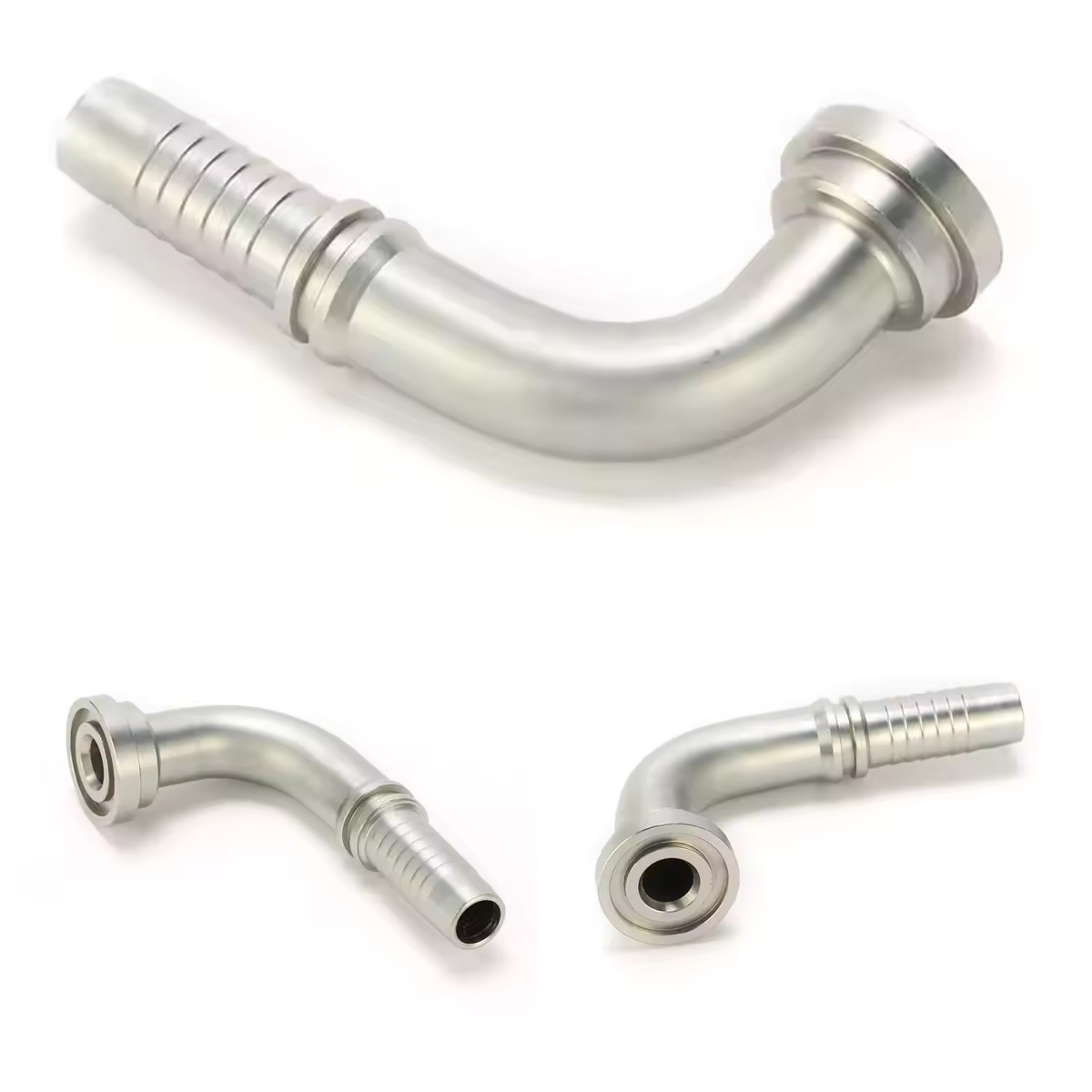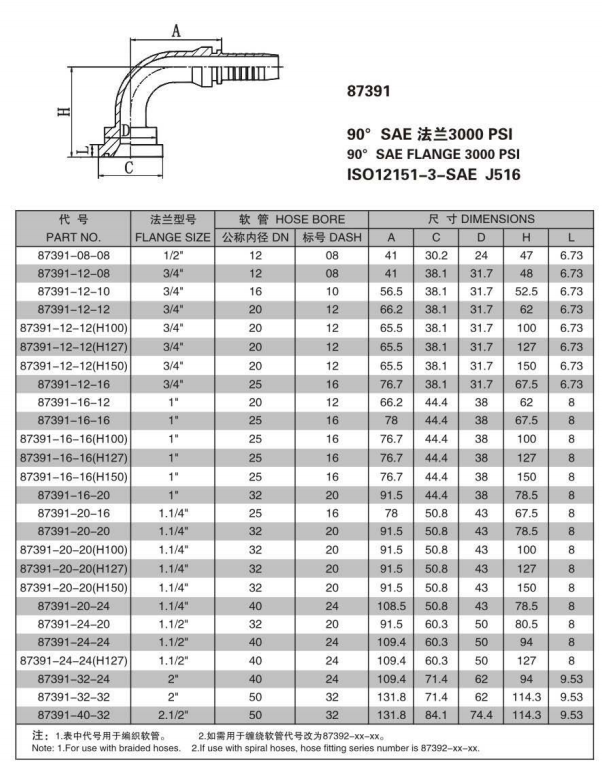Product Description

90 - Degree Angle
The 90 - degree angle of the 87391 flange offers significant advantages in fluid - flow management. It allows for a convenient and efficient change in the direction of fluid flow, which is particularly beneficial in systems where space is limited or where complex piping layouts are required. This angled design helps to optimize the routing of hoses and pipes, reducing the need for additional elbows or bends and resulting in a more compact and organized system installation.
High - Pressure Rating
With a rating of 3000 PSI, this flange is engineered to withstand extreme pressure conditions. It is suitable for use in high - stress hydraulic applications, such as those found in heavy - duty industrial machinery, construction equipment, and high - performance automotive hydraulic systems. The ability to handle such high pressures ensures the safe and reliable transfer of fluids, minimizing the risk of leaks and system failures.
SAE - Compliant Design
The 87391 flange is designed in strict accordance with Society of Automotive Engineers (SAE) standards. This compliance guarantees compatibility with a wide range of SAE - specified hoses and fittings, simplifying installation and maintenance processes. The SAE - compliant design also ensures that the flange meets the industry - recognized quality and performance benchmarks, providing users with confidence in its reliability.
Specification
| Material: | Stainless steel、Carbon Steel、copper |
| Size: | All size |
| Weight: | *g |
| MOQ: | 100pcs |
| Packing: | Carton case |
| Color: | silver |

Advantage
In terms of connection performance
Installation Convenience: Most hydraulic hose fittings are simply designed. For example, quick couplings do not require complex tools or professional skills. The connection and disconnection can be quickly completed by hand or through simple operations.
Firm Connection: Take the crimped hose fitting as an example. Through the crimping process, the fitting and the hose are closely combined. In addition, hydraulic pipe fittings with protective structures prevent loosening through the cooperation of threads and the limiting structure. They can maintain a reliable connection under working conditions such as high pressure and vibration.
Strong Adaptability: There are a variety of specifications, forms and connection methods, which can meet the connection requirements of hydraulic systems with different pipe diameters, pressures, media and installation requirements. They can be well adapted to various hydraulic components such as pumps, valves, and cylinders.
In terms of Sealing Performance
Prevention of Leakage: Advanced sealing technologies and high-quality sealing materials, such as O-rings and sealing rings, are adopted, which can effectively prevent the leakage of media such as hydraulic oil, ensuring the stability of the system pressure and the transmission efficiency of the media.
Maintaining Cleanliness: Good sealing performance can prevent external impurities such as dust and moisture from entering the hydraulic system, avoiding system contamination and component wear, and extending the service life of the system and components.
In terms of Working Performance
High Pressure Resistance: These fittings are made of materials such as high-strength metals or high-performance plastics. Through special processing and treatment, they can withstand relatively high working pressures.
Vibration and Flexure Resistance: The hoses of metal hose fittings are hydraulically formed thin-walled stainless steel tubes, which have excellent flexibility and vibration resistance. They can adapt to situations such as equipment vibration, displacement, and distortion, protecting the hoses and ensuring the stable operation of the system.
Corrosion Resistance: Fittings made of stainless steel possess strong chemical resistance and corrosion resistance. Plastic fittings can also operate in corrosive media such as acids and alkalis, making them suitable for harsh environments.
In terms of System Maintenance
Extended Lifespan: These fittings can protect hydraulic hoses from damage such as excessive bending, twisting, and stretching, preventing premature aging and rupture of hoses. For example, swivel hydraulic fittings can eliminate hose twisting, significantly extending the service life of hoses.
Easy Maintenance: In the event of a malfunction, only the damaged fitting needs to be replaced instead of the entire hose or system, reducing maintenance costs and difficulties. Moreover, some fittings are designed to facilitate inspection and repair.
Application
Hydraulic hose fittings are widely used, and the following are some of the main application areas:
Automotive Field
Braking System: When a vehicle brakes, the brake fluid flows from the master cylinder to the wheel cylinders, and it needs to be connected through high-pressure hoses and quick couplings. The quality of these fittings directly affects the braking effect and driving safety.
Steering System: In the power steering system, hydraulic hose fittings are responsible for connecting components such as the power steering pump and the steering gear, enabling the driver to easily operate the steering wheel.
Suspension System: The hydraulic suspension system relies on hydraulic hose fittings to connect components such as hydraulic cylinders, achieving the shock absorption of the vehicle and the adjustment of the vehicle body height.
Construction Machinery Field
Excavators: Hydraulic oil is conveyed to actuating components such as the bucket and the breaker through components like the main pump and the distribution valve. Hydraulic hose fittings need to withstand harsh environments such as high pressure, high temperature, and high friction to ensure the normal operation of the hydraulic system.
Cranes: These fittings are used to connect components of the crane, such as the hydraulic pump, hydraulic cylinders, and hydraulic motors, ensuring smooth and precise movements like lifting, luffing, and slewing.
Bulldozers: They enable the hydraulic system of the bulldozer to achieve reliable connections between various hydraulic components during high-load operations, guaranteeing the smooth implementation of functions such as earthmoving and soil loosening.
Industrial Automation Field
Machining Equipment: In the hydraulic systems of machining centers, numerically controlled machine tools and other equipment, hydraulic hose fittings connect the hydraulic station, hydraulic cylinders and hydraulic valves, etc., providing power for the feeding of cutting tools, the movement of the worktable and other operations.
Automated Production Lines: In automated production lines such as automobile assembly lines and food filling lines, they are used to connect various hydraulically driven robotic arms, fixtures, etc., to achieve operations such as material handling and assembly.
Robots: In hydraulically driven robots, hydraulic hose fittings connect the hydraulic source to the joint hydraulic cylinders of the robot, enabling the robot to perform various complex movements.
Other Fields
Agricultural Machinery: The hydraulic systems of agricultural machinery such as tractors, combine harvesters, and seeders rely on hydraulic hose fittings to connect various components and complete farmland operations.
Oil and Gas Industry: In the hydraulic systems of drilling, pumping, oil field operations and other processes, hydraulic hose fittings with high pressure resistance, high temperature resistance and corrosion resistance are used to prevent leakage and ensure the safe and stable operation of the system.
Transportation Industry: In railway, aviation and marine transportation, hydraulic hose fittings are required for the hydraulic systems that control key components such as brakes, lifting mechanisms, steering systems and suspensions. This ensures that the hydraulic systems of transportation vehicles can operate stably in high-load and high-vibration environments.